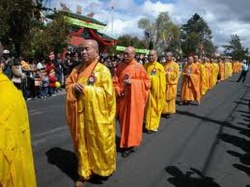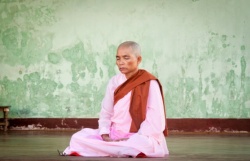Realizing the Four Stages on the Path to Nirvana
As he guided his followers over the 45 years that he taught, Buddha recognized four distinct levels or stages of realization, each one marked by a deep and unmistakable experience of selflessness followed by certain changes in outlook and behavior. The experience generally occurs during intensive meditation, when the attention has become one-pointed, and follows extensive study and understanding of the basic truths of Buddhism (especially the three marks of existence: selflessness, impermanence, and dissatisfaction).
The following list explains the four distinct stages on the path to nirvana.
Stream-enterer: The first direct insight into selflessness is often the most powerful because it's unlike anything you've ever experienced before. For a timeless moment (which may last just an instant), no one is there — that is, there's no trace of a separate self anywhere. A feeling of tremendous relief, often accompanied by joy and bliss, generally follows the experience: At last, you've had the insight you've been seeking for so long. At last, you've "entered the stream" of realization.
When you become a stream-enterer, you can never again believe that you're really a separate self that lives inside your head and looks through your eyes. Your experience forever eliminates this illusion. When you look within, you can't find a self anywhere. In everyday life, however, you may still feel like a separate somebody and may still get caught up by greed, anger, ignorance, and various other negative feelings and patterns. Fortunately, the stage of stream-enterer also brings an unshakable confidence and dedication to the Buddhist spiritual path, so you're motivated to keep deepening and refining your realization.
Once-returner: After you become a stream-enterer, your practice includes reminding yourself of your new realization of "no-self," as well as paying attention to the ways that you're still attached and your resistance to life as it unfolds. After a period of time (generally years of devoted practice) in which your concentration gets even stronger and your mind becomes even more tranquil, you have another direct insight into no-self. (Remember, knowing this truth as a concept or memory is one thing, but experiencing it directly, beyond the conceptual mind, is something else entirely.)
This insight (essentially the same as the first but even stronger and clearer) brings a significant reduction in attachment and aversion and the suffering that accompanies these states of mind. For example, occasional irritation and preference replace hatred and greed, which no longer have any hold over the once-returner. Someone who reaches this stage has only one more rebirth before becoming completely enlightened — hence the name once-returner.
Never-returner: After the experience that signals entry to this stage, all of the worst hindrances, such as hatred, greed, jealousy, and ignorance, completely drop away, but a hint of a self-sense (a "me") still remains — and with it, the slightest trace of restlessness and dissatisfaction sticks around as well. The experience itself is rarely accompanied by any emotion or excitement, just a clearer recognition of what has already been seen twice before. These people appear to be extremely content, peaceful, and without desire, but the subtlest preference for positive rather than negative experiences remains.
Arhat: At this stage, the path bears ultimate fruit in nirvana — any residual trace of a separate self falls away for good. The experience, frequently accompanied by unimaginable bliss, has been compared to falling into the depths of a cloud and disappearing. At this point, the circumstances of life no longer have the slightest hold over you; positive or negative experiences no longer stir even the slightest craving or dissatisfaction. As Buddha said, all that needed to be done has been done. There's nothing further to realize. The path is complete, and no further rebirths are necessary.

